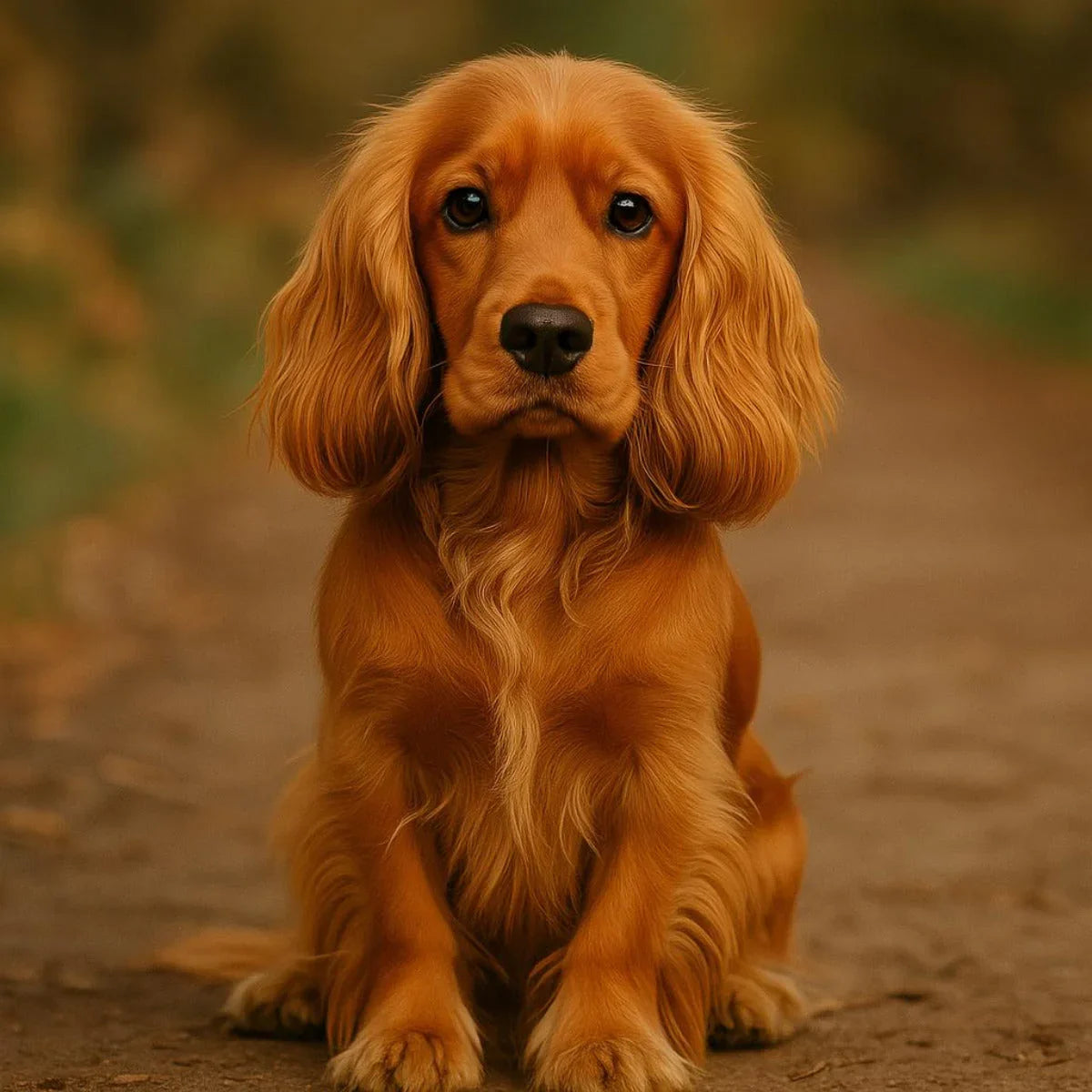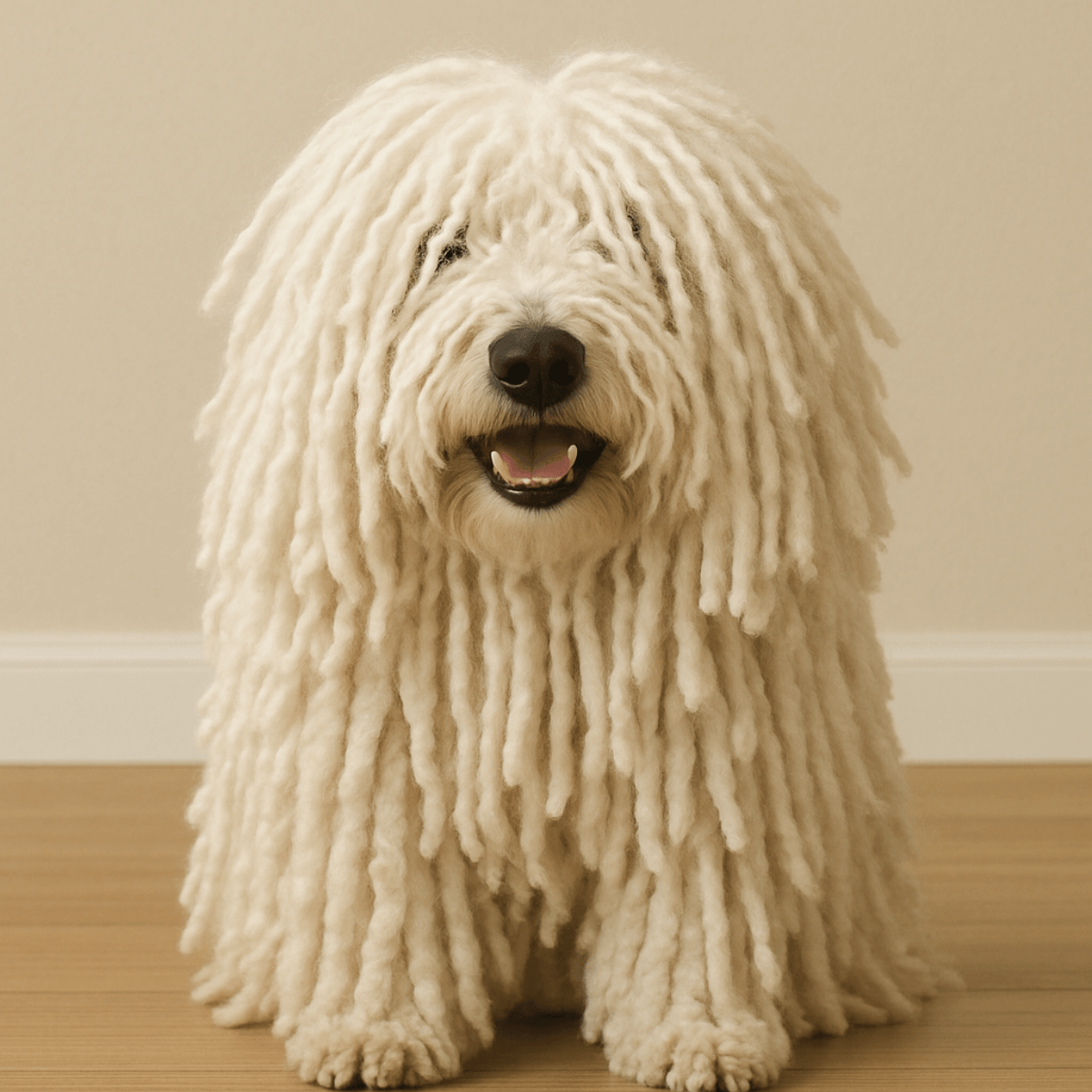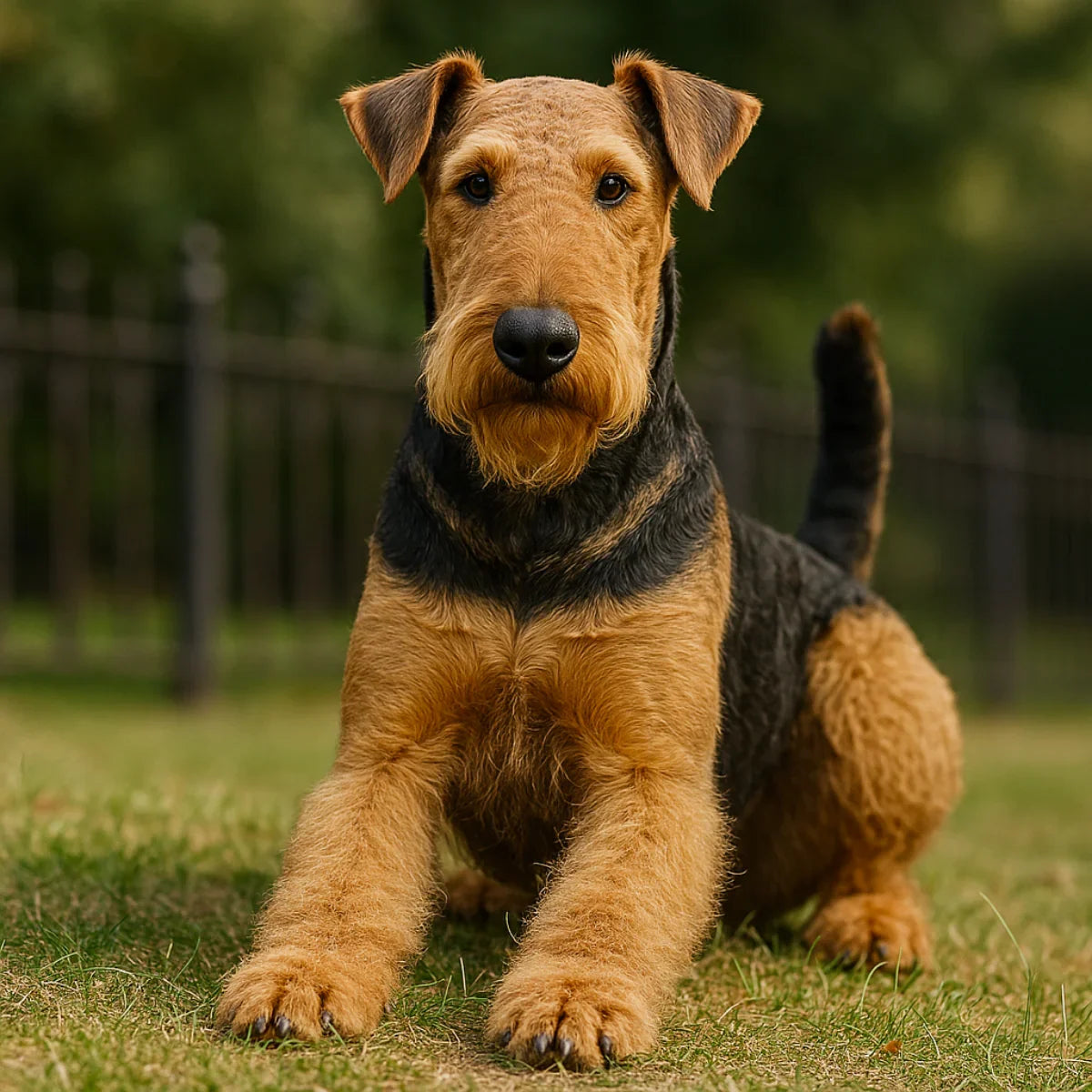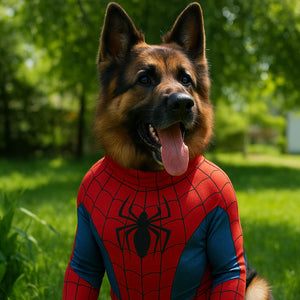
Cocker Spaniel: Why Is It One of the Best Breeds for Families with Children?
Introduction: A Dog's Heart in an Athlete's Body - Meet the Cocker Spaniel Who Will Conquer Your Life
There are dogs that inspire respect. There are those that melt your heart. And then there are those that combine everything—elegance, energy, and a huge heart. The Cocker Spaniel is exactly that kind of dog. The moment he enters a room, his long, wavy ears and keen gaze bring a smile to the face of everyone who meets him. And when he starts wagging his tail with excitement, there's no one who wouldn't feel a liking for him.
This breed combines two seemingly contradictory natures. On the one hand – an aristocratic appearance, a dignity straight from an English estate, an exemplary presence at dog shows, and a soft and shiny coat that adorns its slender body like a noble coat. On the other – the soul of a joyful adventurer, always eager to play, move, and… follow its owner to the ends of the earth. Because if this dog loves one thing above all else – it's people.
This dog does not accept compromises: he wants to live intensely, love limitlessly and be where life is vibrant.
His history dates back centuries, when, as a hunting dog, he bravely combed through dense undergrowth in search of woodcock, a forest bird. His genes still remember those times – which is why he thrives on exercise, play, training, and exploring new areas. And yet, as soon as evening comes, he nestles tenderly into his owner, as if to say, "Thank you for being here."
A Cocker Spaniel is more than just a dog. It's an emotion. It's the quicksilver in a dog's fur. It's a friend who understands without words.
In this article, we'll tell you everything you need to know about this extraordinary breed. We'll delve into its fascinating history , discuss its character and temperament , show you how to care for its coat and health , and advise you whether this dog is right for you . You'll learn about its upbringing, diet, daily routine, and the extraordinary relationship you can build with this dog.
If you're wondering if a Cocker Spaniel can change your life, the answer is yes. But don't take our word for it. Get to know him better and see for yourself.
Contents:
- History of the Cocker Spaniel Breed
- Appearance and Variations (English vs American)
- Character and temperament
- Who is the Cocker Spaniel for?
- Education and training
- Coat care and daily hygiene
- Health and life expectancy
- The perfect diet for a Cocker Spaniel
- Interesting facts about the breed
- Summary: Is a Cocker Spaniel the dog for you?
1. The history of the Cocker Spaniel breed – from the wilds to the hearts of people around the world
Every breed has its own history, but not all can boast a past as colorful and rich as the Cocker Spaniel. While most of us today know them as charming family dogs that gracefully stroll through parks and cuddle on the couch, their origins were much more… outdoor.
🐾 English hunter pedigree
The breed's roots date back to medieval England, where Cocker Spaniels belonged to a broad group of dogs known as "spaniels" – used primarily for hunting. Their role was to flush birds from dense undergrowth and retrieve hunted game. Small, agile, with an excellent sense of smell and hunting instincts, they were ideal companions for hunting woodcock, from which they derive their name – "Cocker."
📜 From utility to exhibition breed
For many years, spaniels were not classified as separate breeds—they were divided primarily by size. The smaller, more compact breeds—ideal for working in dense undergrowth—over time began to be recognized as a separate group, giving rise to the English Cocker Spaniel. It was in the 19th century, with the development of cynology and the creation of the first pedigrees, that breed characteristics began to be standardized and selective breeding began.
In 1892, The Kennel Club officially recognized the Cocker Spaniel as a distinct breed. Around the same time, exports of these dogs to North America began, where, over the decades, a distinct breeding line developed, more suited to exhibitions than field work.
🇬🇧 vs 🇺🇸 – English and American Cocker Spaniel
In the 20th century, the differences between dogs from England and the USA became so clear that in 1946 the American Cocker Spaniel was officially recognized as a separate breed.
| Characteristic | English Cocker Spaniel | American Cocker Spaniel |
| Construction | More elongated, elegant | Shorter muzzle, more rounded head |
| Application | A working and hunting breed | Show and companion breed |
| Character | Energetic, independent | Gentler, more "soft" |
| Hair | Longer, more wavy | Very rich, smooth and soft |

Today, both varieties enjoy immense popularity worldwide. Although their purpose has changed – from working dogs to family dogs – many of their hunting traits remain. To this day, Cocker Spaniels love to track, dig, retrieve, and use their noses. At the same time, they can spend hours dozing at their owners' feet, gazing into their eyes with undisguised affection.
🐶 Cocker Spaniel Today – A Legacy That Lives On
Regardless of its variety, the Cocker Spaniel remains one of the most recognizable and beloved breeds in the world. You'll find it in the homes of dog lovers, in the show ring, in dog sports, or as a therapy dog helping people with autism or depression. This is proof that this breed has not only stood the test of time but has gained a completely new meaning in the modern world.
2. Appearance of the breed – velvet ears, gaze full of emotion
When you look into a Cocker Spaniel's eyes, you'll see more than just a reflection of light. You'll see emotions—concern, joy, longing. This is a breed that speaks without words, and its appearance is so distinctive that it's difficult to confuse it with any other dog. The Cocker Spaniel is a combination of nobility and the charm of childlike innocence, embodied in a harmoniously constructed silhouette.
📏 Silhouette and size
The Cocker Spaniel is a medium-sized dog with a compact yet muscular build. Its slightly elongated body, with a deep chest, well-muscled limbs, and a straight back, makes it both elegant and ready for physical activity. The breed has a natural grace, moving with a spring in its step, lightness, and confidence.
Standard dimensions:
- Males: 38–43 cm at the withers, 13–16 kg
- Females: 36–41 cm at the withers, 12–15 kg
Even though it is not a large dog, it gives the impression of being strong and very agile – it is no coincidence that for centuries it has been chosen for work in difficult terrain.
👂 Ears like velvet fabric
One of the Cocker Spaniel's most captivating features is its long, drooping ears, covered in silky, often slightly wavy fur. These ears not only add to its charm but also served a practical purpose, protecting the ear canal from branches and dust during hunting trips.
This isn't just a functional feature, though—their ears move gracefully when in motion, making the Cocker Spaniel one of the most photogenic dog breeds. Grooming them, however, is a challenge—their ears are susceptible to infection and require regular cleaning.
👀 A look that disarms
The Cocker Spaniel's eyes are another hallmark of this breed. Large, dark, deep-set and wide apart, they convey a warm and gentle expression. This gaze, which "speaks" to humans, is one of the most common reasons we fall in love with this breed. It reflects intelligence, empathy, and an incredible need for connection.
🧥 Coat – beautiful and demanding
The Cocker Spaniel's coat is soft, dense, and pleasant to the touch. It can be slightly wavy or almost straight—but never curly. The distinctive fringes on the ears, belly, paws, and tail require regular brushing and trimming.
If not properly cared for, mats can form very quickly, especially behind the ears and in the groin area. This breed is demanding in terms of grooming, both at home and professionally.
🎨 A wealth of colors – Cocker in every color
One of the breed's greatest visual advantages is its wide variety of coat colors . Regardless of preference, there's something for everyone. The breed allows for both solid and multi-colored coats.
The most common colors:
- Solid: black, chocolate (liver), gold, cream, red
- Two-color (particolor): black and white, chocolate and white, gold and white
- Tricolor: black, white and tan, chocolate, white and tan
- Roan: blue roan (black-gray), liver roan (chocolate-gray), orange roan, lemon roan
Some dogs also have striking tan markings , which are lighter markings above the eyes, on the muzzle, chest, and paws. Coat color doesn't affect personality , but it often determines the preferences of future owners.
🐕 Tail – full of expression
Although Cocker Spaniels' tails were often docked in the past (especially in the working breed), this procedure is now banned in many countries, including Poland. This allows us to admire their naturally active, expressive tails, which perfectly reflect the dog's mood. When happy, their tails literally vibrate with joy.
3. Character and temperament – a dog with the heart of a child
Some dogs are charming. Others are intelligent. And there are those who possess both, enriched by an incredible capacity for expressing emotion. The Cocker Spaniel is precisely such a dog. Their demeanor exudes an extraordinary harmony between energy and sensitivity, joy and empathy. This is a dog that experiences everything right alongside you – your successes, your sorrows, your daily life. And that's precisely why so many people fall head over heels in love with them.
🐾 Cocker Spaniel – an emotional companion from day one
The Cocker Spaniel is a dog with an exceptionally social nature. He thrives among people – not as a background, but as a full-fledged member of the family. He loves being the center of attention, loves petting, and spending time together, and every time his owner returns home is a celebration for him. This is a dog that greets you every day as if you were returning after years of separation.
💗 Characteristic features of temperament:
- Joyful and lively – full of energy, ready to play, run, discover the world.
- Emotional and devoted – it becomes strongly attached to its caregiver, showing love with gestures and looks.
- Sociable and gentle – he gets along great with children and other dogs (and often cats).
- Sometimes possessive – can be jealous of attention, especially if he feels left out.
- Emotionally sensitive – reacts strongly to shouting, stress and a tense atmosphere.
- Smart and intelligent – learns commands and instructions quickly, but needs a gentle approach.
👶 The perfect dog for children?
Yes, the Cocker Spaniel is one of the best breeds for families with children. They have a gentle disposition, are patient, and love to play. They eagerly participate in children's games, fetch toys, and run around the garden. They are intelligent enough to sense the tenderness of the youngest, yet strong enough to keep up with more energetic little ones.
🔔 Note: It is worth teaching children respect for dogs - the Cocker Spaniel, although gentle, has limits, like any animal.
🐶 Relationships with other dogs and animals
The Cocker Spaniel is a friendly and communicative dog. He thrives in a group, readily interacts with other dogs on walks, and is not aggressive, although he may occasionally try to assert his position if he feels threatened or neglected. His gentle nature also allows him to bond well with cats, especially if he was raised with them from a young age.
🧠 Intelligence and learning ability
Cocker Spaniels are intelligent, observant, and trainable dogs. They love learning new things, especially when motivated by treats and praise. They respond quickly and can focus on a task, but they require short, varied sessions—boredom can discourage them.
Thanks to this, they work well:
- In dog sports (agility, nosework, obedience),
- As therapy dogs,
- In basic and advanced obedience.
😔 Sensitivity and separation anxiety – the darker side of emotionality
What makes the Cocker Spaniel so close to humans also has a dark side. This breed doesn't handle loneliness well. If left alone for long periods of time, they can develop separation anxiety. This manifests itself in:
- Howling and barking,
- Destroying objects,
- Apathy or over-excitement.
🔑 Solution: teach your dog independence from puppyhood, leave him for short periods of time, provide him with interactive toys and a safe space.
💬 Voice of Emotion
The Cocker Spaniel is a "talkative" dog. He can express his needs vocally—barking, whining, even purring. While not a noisy breed, he won't hesitate to say, "I want to go for a walk!" or "I don't like this silence..."
4. Who is the Cocker Spaniel for?
This is a dog for a person who:
- He has time for daily walks and play,
- I want a family dog, but at the same time active,
- She is ready for regular coat care,
- Looking for a loyal and affectionate dog,
- He values contact, loyalty and a dog's joy of life.
👨👩👧👦
- For families with children,
- For singles who want a companion for everyday life,
- For older people who need warmth and routine,
- For active people, but also those who value peace and quiet at home,
- For all those who treat a dog as a full member of the family .
This breed isn't ideal for those who spend all day away from home. The Cocker Spaniel needs human company like it needs air.
5. Education and training – intelligence is not everything
At first glance, the Cocker Spaniel, with its sharp gaze, alertness, and zest for life, might seem like a self-trained dog. After all, it picks up new commands so quickly, responds so readily to praise, and seems to understand perfectly what is expected of it.
But that's only part of the truth.
In reality, they're a highly sensitive breed, and training them requires not only consistency but, above all, empathy. While the Cocker Spaniel has the potential to be an ideal companion, if mistreated, they can develop anxiety, insecurity, and even depression.
🧠 Intelligence? Yes. But combined with emotion.
Cocker Spaniels rank high on the list of most intelligent dog breeds. They are:
- Keen observers – they learn quickly through imitation,
- They are memorable – they remember good (and bad) experiences for a long time,
- Motivated – if they know they will receive praise, a treat or a moment of closeness.
However, with this intelligence comes a strong emotionality . These are not "cold" and analytical dogs. They are emotional beings who learn through relationships and the atmosphere. Therefore , yelling, harsh punishment, or harsh discipline can do more harm than good .
✅ Basic rules for effective training of a Cocker Spaniel:
- Start training as early as possible – preferably as early as 8 weeks of age, when the puppy absorbs knowledge like a sponge.
- Enroll your dog in dog kindergarten – contact with other dogs and learning basic commands in a controlled environment is an invaluable start.
- Use positive reinforcement – reward good behavior with treats, praise and play.
- Be consistent – if something isn't allowed one day, it can't be allowed the next. Chaos in the rules = lost dog.
- Avoid shouting, coercion, or physical punishment – instead, try calming down, ignoring the undesirable behavior, or interrupting the play.
- Encourage mental activity – hide-and-seek games, smell mats, simple logic puzzles with food.
- Daily routines and rituals – they give the dog a sense of security and predictability.
📌 What commands are worth introducing at the beginning?
Cocker Spaniel, as a lively and curious dog, should know a set of commands that will ensure its safety and help in everyday functioning:
- “Sit” and “Lie down” – the basics of self-control,
- “Stay” – important on walks and at home,
- “Come back”/“Come back” – crucial for the dog’s safety in open spaces,
- “No” or “Leave it” – helps to stop undesirable behavior,
- “In place” – builds a ritual of rest.
🎓 Training through play – a way to combat boredom and bond
Cocker Spaniels love to play – a huge advantage when training them. Incorporate educational elements into your daily activities:
- Fetching with the “fetch” command – develops obedience and contact with the owner,
- Smell games – a natural need to work with the nose, which calms down and teaches concentration,
- Tug of war with the principle "let go on command" - strengthens control and cooperation.
🚫 Most common mistakes in Cocker Spaniel training:
- Lack of patience – expecting results quickly may discourage the dog and the owner,
- Punishing for fear – for example, for peeing in the house or hiding – increases uncertainty and stress,
- Too difficult or monotonous exercises – they bore the dog and cause frustration,
- Command overload – too much information at once leads to chaos in the dog's head.
❤️ Building trust is key
Training a Cocker Spaniel isn't just about learning behaviors, it's about building relationships. If your dog knows he can trust you, he'll become your shadow, your partner, your emotional rock. And what you call "training" today will become your shared language tomorrow.
6. Grooming a Cocker Spaniel – Softness Takes Work
The Cocker Spaniel's beautiful coat is its pride and joy… and a challenge for its owner. It requires regular brushing (at least 3–4 times a week) and grooming visits.

The most important treatments:
- Brushing and combing – prevents tangles,
- Baths every 4–6 weeks – using mild shampoos,
- Ear cleaning – long ears are prone to infections,
- Claw trimming – once a month,
- Visits to the groomer – at least once every 2 months.
7. Health – what should you look for in a Cocker Spaniel?
Although the Cocker Spaniel is considered a generally healthy and long-lived breed, like any dog, it has its weaknesses. It is a breed with a strong temperament, but also a delicate physique that requires proper attention from its owner, especially in terms of preventative care.
🦻 Be careful with your ears – they are a paradise for bacteria and fungi
The Cocker Spaniel has long, drooping ears that are poorly ventilated. This allows moisture and heat to accumulate inside them – ideal conditions for inflammation. Ear infections (otitis externa) are one of the most common ailments in this breed.
🔍 Symptoms:
- Scratching ears, shaking head,
- Unpleasant odor from the ear canal,
- Excessive earwax or discharge.
✅ What to do: clean your ears regularly, avoid wetting your head while bathing, react immediately to the first symptoms.
👁️ Eye diseases – an eye full of emotions, but also risk
Due to their large, bulging eyes, Cocker Spaniels are at risk of:
- Cataracts – especially in old age,
- Entropion – i.e., the eyelid turning in, which can irritate the cornea,
- Cherry eye – prolapse of the third eyelid in some individuals.
🦴 Joints and skin – support from an early age
- Hip dysplasia is a hereditary disease, so it is worth choosing dogs from breeders that perform genetic testing.
- Skin problems – tendency to allergies, hot spots, atopy.
It is recommended:
- Administering omega-3 fatty acid supplements ,
- Use of hypoallergenic food if hypersensitivity is suspected.
⚖️ Obesity – a weakness of this breed
The Cocker Spaniel has a huge appetite and can be a bit gluttonous. Unfortunately, they also tend to gain weight, which can worsen joint, heart, and metabolic problems.
✅ Regular weight monitoring, limiting snacks and an active lifestyle are the basis of a Cocker Spaniel's health.
📆 Lifespan: 12–15 years – with proper care, a balanced diet and exercise.
8. The Perfect Diet for a Cocker Spaniel – Health Starts in the Bowl
What goes into your dog's bowl directly impacts their well-being, immunity, coat appearance, and lifespan. For a breed as emotional and delicate as the Cocker Spaniel, a good diet isn't a luxury—it's a necessity.
✅ What should the ideal food contain?
- A large proportion of meat – preferably dried or fresh,
- No grains (especially wheat and corn),
- Sources of omega-3 and omega-6 fats – e.g. salmon oil,
- Addition of vegetables and fruit – as a source of fiber and vitamins.
❌ What to avoid?
- Cheap fillers (gluten, soy, artificial colors),
- Excess fat in less active dogs,
- Leftovers from the human table – can cause digestive disorders and allergies.
💡 Supplementation: it is worth including preparations that support joints, immunity and digestion – after consulting a veterinarian.
🧴 Water: Cocker Spaniels should have constant access to fresh, clean water – especially in summer or after activity.
9. Cocker Spaniel Fun Facts – Things You Didn't Know!
🐾 1. Movie Star: In Disney's animated film "Lady and the Tramp," the character of Lady was based on an American Cocker Spaniel. Her gentleness, loyalty, and charm won the hearts of millions.
👑 2. A favorite of the elite: Cocker Spaniels were one of the favorite breeds of Queen Victoria and later members of the British royal family. They are still considered a "classy" breed to this day.
🇺🇸 3. Division into breeds: Although today we treat the English and American Cocker Spaniel as separate breeds, their separation took place only in 1946, at the request of the American Kennel Club.
👃 4. Sniffing Masters: Thanks to their incredibly keen sense of smell, Cocker Spaniels are sometimes used as drug detection dogs, pest detection dogs, and even as sniffer dogs in the forests.
10. Summary – is a Cocker Spaniel the dog for you?
Choosing a dog is a decision that will last for years. It's not just about appearance, but also about lifestyle, daily routine, and emotional connection. The Cocker Spaniel is a breed that:
✅ She is beautiful and graceful ,
✅ Loves people, especially children ,
✅ Loves fun and movement ,
✅ Learns easily and loves challenges ,
✅ But it also needs time, closeness and attention .
This isn't a dog for everyone. If you're looking for a couch potato who won't budge from his bed for 10 hours a day, this isn't the breed for you. But if you want a companion who will always be there for you, who will give you unconditional love, yet still demand your commitment, then a Cocker Spaniel could be your ideal pet.
📚 Additional materials
- How to Tell If Your Dog Is Bored: 10 Signs You Can't Ignore
- TOP 10 Most Intelligent Dog Breeds – Which Ones Will Surprise You With Their Cleverness?
- Best dogs for apartments – breed ranking
- How Do Dogs Show Affection? Signals You Should Know
- Is Your Dog Pulling on the Leash? Find Out How to Fix It
-
How to safely transport a dog in a car?
See more at: Petto.com.pl







 https://petto.com.pl/
https://petto.com.pl/